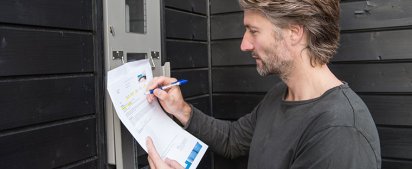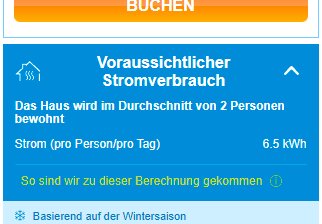Additional costs in the holiday home for consumption (electricity, water, etc.)

When you rent a holiday home in Denmark or a holiday apartment, additional costs such as electricity or water consumption are not included in the rental price.
This means that all our rental prices are exclusive of ancillary and consumption costs for electricity, heating, water, oil, district heating or special equipment, cleaning and the like, unless otherwise stated in the description of the holiday home. We ask for your understanding that price changes in additional costs may occur due to changes in consumer prices.
Due to the current price of energy, which we unfortunately cannot control or predict, we would like to inform you of this as a precaution:
On our website you will find information about the current weekly price for each holiday home, which is what we charge for the cost of energy at the time, but it may change by the time you arrive, depending on changes in energy costs.
Therefore, these prices for additional costs are not included in your rental agreement when you book. The prices that are binding on you and Esmark for the consumption costs that we will charge for your stay will be shown on your consumption cost bill on the day of your arrival.
How much electricity does a holiday home use?
Unfortunately, it is very difficult to give a guideline for electricity consumption as it depends on many factors: Age and construction of the holiday home, time of year, size and furnishings, number of people, etc.

However, on our website you can find out the approximate electricity consumption you can expect in many of our holiday homes. You can find this information under "Expected Electricity Consumption" on the page for each holiday home.
The figures are an average based on the consumption of previous guests.
But there are a few things to bear in mind:
The value shown is a very rough average and your actual consumption may vary.
Consumption is shown for the summer or winter season, depending on the date selected.
Consumption data is not yet available for our new holiday homes.
Total consumption and the average may increase more if the holiday home has a charging point for electric cars.
Have you already chosen a holiday home and are unsure of the additional costs?
Feel free to contact us and we can look at the average cost of the holiday home (please note that this is only a rough guide and, as mentioned above, can vary greatly from individual to individual).
Reading the meters on arrival at your holiday home
When you collect your keys, you will also receive some arrival information and an information guide with practical details about your holiday home. In your Esmark guest login you can always click on Your digital billing of consumption costs, where you will be asked to read the meters in your holiday home on arrival and on departure.
As you have to take the readings yourself, you can also check your consumption yourself on an ongoing basis and keep an eye on your consumption costs.
Settlement of ancillary costs
Water consumption: Charged on departure according to consumption. Find out more here.
Electricity: Charged according to consumption on departure.
Oil: Only some properties charge according to consumption on departure. See the property description for details.
District heating: Only some properties charge according to consumption on departure. Please refer to the property description for details.
Some of our holiday homes are equipped with environmentally friendly energy sources such as geothermal energy, a special heat pump or solar heating. Billing according to consumption on departure. The price/per unit depends on the type of meter. Information can be found in the holiday home description.
You must settle the additional costs at our office on your departure and pay either by direct debit, credit card or in cash.
Convenient management of consumption costs in the guest login
In your Guestlogin "MyEsmark” you can view your digital consumption cost bill and enter the meter readings yourself.
When you leave, you can conveniently pay your bills by direct debit. This ensures that you always have a complete overview of your costs and that your stay at Esmark remains pleasant and uncomplicated.
Tips for saving electricity when on holiday
Even when you are on holiday in a holiday home in Denmark you can easily save energy and thus reduce the cost of your electricity consumption. Not only will you be doing something good for the environment, but you can also save on your ancillary costs.
We have put together a few tips to help you minimise your electricity costs (so you have more money to spend on soft ice cream ;o).
Measuring & controlling electricity consumption
As electricity consumption is not usually included in the rental price, you will need to record the meter readings at the property on arrival and departure for billing purposes on your digital consumption cost statement. This will also show you the price for each unit.
We recommend that you keep an eye on your meter readings regularly, even when you are on holiday, so that you can keep track of your costs and see if you can save even more electricity.
If possible, switch off any electronic devices you have brought with you
Many unused electronic devices use unnecessary powe,r even in standby mode. These include chargers for tablets, smartphones and camera batteries, as well as the TV or Playstation.
However, standby consumption is usually low and the potential savings are manageable. Only if you have many and/or older standby (charging) devices can you save more by switching them off, even when you are on holiday. Before going on holiday, it is best to unplug all unnecessary electronic equipment at home.
Depending on the type of holiday home you have, there may be other electrical appliances that need to be left on, such as pool and jacuzzi equipment, dehumidifiers and internet routers.
We particularly recommend that chargers should always be unplugged or switched off after charging, as almost all sockets in Denmark have a circuit breaker.
Saving electricity in the holiday home kitchen
Even small changes in the kitchen can help reduce electricity costs. When cooking, use only as much water as you need and, if available, always use a lid.
There is also potential for savings when you go to the fridge: please remember that every time you open the door, warm air enters the fridge Refrigerator which has to be cooled down again. So always close the door as quickly as possible.
Dishwashers sometimes have a special economy programme, which you should only use when the dishwasher is completely full. Smaller amounts of dishes can be washed by hand.
Laundry in the holiday home
Normal washing is often washed at far too high a temperature, wasting a lot of energy. A wash cycle at 30, 40 or 50 degrees Celsius is sometimes enough instead of 60 or even 90 degrees. Reducing the temperature by as little as 10 degrees will also help reduce energy consumption.
Tumble drying
If possible, avoid using an electric tumble dryer altogether and just leave your clothes to dry here in the fresh sea air. You can save a lot of energy and protect your clothes at the same time, and the fresh west wind usually dries them very quickly.
Don't have a clothesline or clotheshorse at home? Stop by our office and we will be happy to lend you one.
Lower the temperature in your holiday home and keep it constant
The heat pump or electric heaters should not heat up and down the rooms unnecessarily, it is advisable to use a constant temperature and shock ventilation several times a day. A room temperature between 19 and 21 degrees is optimal for comfort. Temperatures above this often mean significantly higher energy costs.
However, to prevent mould growth, rooms should never cool down completely, and if the humidity is too high (over 60%), ventilate regularly.
Heating with a stove in a holiday home
In addition to a heat pump or electric heating system, many holiday homes are equipped with a stove that you can use to heat your home. Not only does it create a cosy, hygge atmosphere in your holiday home, but it can often heat the living space to a comfortable temperature in a short space of time, so that radiators or even a heat pump do not need to be used for additional heating.
Regulating underfloor heating down
Many holiday homes have underfloor heating in the bathroom or other rooms, and turning it down by a few degrees can often significantly reduce energy consumption. Turning it up and down too often also increases energy consumption, so keep the temperature as constant as possible.
However, keep an eye on the outside temperature and humidity to prevent mould or damage to the house.
Energy saving tips for holiday homes with swimming pool
Energy costs, especially electricity consumption, are much higher in a holiday home with pool than in a traditional holiday home without a swimming pool. This is because the pool heating, filtration and dehumidification systems are in constant use.
If available, the pool should be covered with the pool cover after each use to keep the temperature constant.
If possible, wet towels should be dried outside in the wind rather than in the pool room, and wet floors in the pool area should be dried with a squeegee, as this will reduce the need for the dehumidification system to work and therefore use less electricity.
If the pool has a counter-current system, it is best to switch it on immediately after use, as the pump needs a lot of power to create a counter-current in the water. Note: Many counter-current systems do not switch off automatically!
Energy saving tips for holiday homes with a sauna
If your holiday home is equipped with a sauna, electricity will be consumed during each sauna session. We recommend that you schedule a sauna session during the day, do not use the heater unnecessarily or leave the sauna running several times a day to heat up.
Energy saving tips for Holiday homes with hot tub
A holiday home with hot tub uses more electricity than a traditional holiday home. The costs can vary greatly depending on the type of hot tub and its location (outdoor hot tub, indoor hot tub, hot water tank, instant water heater, etc.).
Standing water hot tubs
If your holiday home has a standing water hot tub, the energy costs will be much higher as it will need to be constantly heated and the water filtered just like a normal swimming pool. The advantage, of course, is that you can use it immediately without having to wait for it to heat up.
A hot tub is drained, cleaned and in many cases refilled automatically on the day you change it. This means that it can take up to 24 hours for the water to be completely warm when you get in. Some freestanding hot tubs do not fill automatically when they are occupied and must be refilled by the guest at the touch of a button or tap. These only use energy when they are switched on again.
A freestanding hot tub often has a cover; we recommend that you replace it after each use so that only a small amount of heat escapes.
All of the above tips for saving energy on holiday in a holiday home were provided to us by the energy broker and owner of mps-solutions, Mogens Pilgaard Sørensen who has 15 years of experience in the energy market.
Find your holiday home
